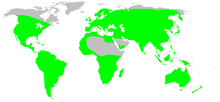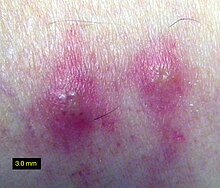Trombiculidae
| Trombiculidae | |
|---|---|

| |
| Trombiculid mite larva | |
| Scientific classification | |
| Domain: | Eukaryota |
| Kingdom: | Animalia |
| Phylum: | Arthropoda |
| Subphylum: | Chelicerata |
| Class: | Arachnida |
| Order: | Trombidiformes |
| Suborder: | Prostigmata |
| Infraorder: | Anystina
|
| Superfamily: | Trombidioidea |
| Family: | Trombiculidae Ewing, 1929[1] |
| Type genus | |
| Trombicula Berlese, 1905
| |
| Genera[2] | |
| |

| |
| The distribution of trombiculid species, which is nearly everywhere in the world. | |
Trombiculidae ( Humans, being animals, are possible hosts.
Trombiculidae live in forests and grasslands and are also found in the vegetation of low, damp areas such as woodlands, berry bushes, orchards, along lakes and streams, and even in drier places where vegetation is low, such as lawns, golf courses, and parks.[8] They are most numerous in early summer when grass, weeds, and other vegetation are heaviest. In their larval stage, they attach to various animals, including humans, and feed on skin, often causing itching. These relatives of ticks are nearly microscopic, measuring 400 µm (1/60 of an inch) and have a chrome-orange hue.[9][10] There is a marked constriction in the front part of the body in the nymph and adult stages. The best known species of chigger in North America[11] is the hard-biting Trombicula alfreddugesi of the Southeastern United States, humid Midwest[12] and Mexico. In the UK, the most prevalent harvest mite is Neotrombicula autumnalis, which is distributed through Western Europe to Eastern Asia.[13]
Trombiculid mites go through a lifecycle of egg, larva, nymph, and adult.[14] The larval mites feed on the skin cells of animals. The six-legged parasitic larvae feed on a large variety of creatures, including humans, rabbits, toads, box turtles, quail, and even some insects. After crawling onto their hosts, they inject digestive enzymes into the skin that break down skin cells. They do not actually "bite", but instead form a hole in the skin called a stylostome and chew up tiny parts of the inner skin, thus causing irritation and swelling. The itching is accompanied by red, pimple-like bumps (papules) or hives and skin rash or lesions on a sun-exposed area. For humans, itching usually occurs after the larvae detach from the skin.[15]
After feeding on their hosts, the larvae drop to the ground and become nymphs, then mature into adults, which have eight legs and are harmless to humans. In the postlarval stages, they are not parasitic and feed on plant material. The females lay three to eight eggs in a clutch, usually on a leaf or among the roots of a plant, and die by autumn.[15]
History
Trombiculidae, from
References to chiggers, however, go as far back as sixth-century China, and by 1733, the first recognition of trombiculid mites in North America was made (citation needed). In 1758,
Distribution
Trombiculid mites are found throughout the world. In Europe and North America, they tend to be more prevalent in the hot and humid regions. In northern Europe, including the British Isles where they are called harvest mites, the species
Life cycle

The length of the mite's cycle depends on species and environment, but normally lasts two to 12 months. The number of cycles in a year depends on the region. For example, in a temperate region, only three per year may occur, but in tropical regions, the cycle might be continuous all year long.[14] Adult harvest mites winter in protected places such as slightly below the soil surface. Females become active in the spring, and once the ground temperature is regularly above 16 °C (60 °F), they lay eggs in vegetation, up to 15 eggs per day. The eggs are round and are dormant for about six days, after which the nonfeeding prelarvae emerge, with only three pairs of legs. After about six days, the prelarvae grow into their larval stage.[14]
Larva
The larvae, commonly called chiggers, are about 170–210 μm (0.007–0.008 in) in diameter, normally light red in color, and covered in hairs; they move quickly relative to size. The larvae congregate in groups on small clods of soil, in matted vegetation, and even on low bushes and plants, where they have more access to prospective hosts.
The larval stage is the only parasitic stage of the mite's lifecycle. They are parasites on many animals. About 30 of the many species in this family, in their larval stage, attach to various animals and feed on skin. This often causes intensely itchy, red bumps in humans.[14][22]

Chiggers attach to the host, pierce the skin, inject enzymes into the bite wound that digest cellular contents,[23] and then suck up the digested tissue through a tube formed by hardened skin cells called a stylostome.[24] They do not burrow into the skin or suck blood, as is commonly assumed. Itching from a chigger bite may not develop until 24–48 hours after the bite, so the victim may not associate the specific exposure with the bite itself.[15] The red welt/bump on the skin is not where a chigger laid eggs, as is sometimes believed.[25] The larvae remain attached to suitable hosts for three to five days before dropping off to begin their nymphal stage.[14] They tend to attach where clothing has restrictions, such as belt lines, or behind the knees when wearing jeans.
During the wet season, chiggers are usually found in tall grass and other vegetation.[26] During dry seasons, chiggers are mostly found underneath brush and shady areas.[25][27] Standing still or lying in tall grass gives them more time to climb onto a person.
Nymph
Once the larva has engorged itself on skin and has fallen off its host, it develops to its nymph stage. The nymph is sexually immature, but more closely resembles the adult.
This stage consists of three phases, the protonymph, deutonymph, and tritonymph. The protonymph and tritonymph morphologies are unusual in species of Trombiculidae. The protonymph phase combines larval and protonymph characteristics with deutonymph and tritonymph morphology.[28] The protonymph is an inactive transitional stage. The active deutonymph develops an additional pair of legs (for a total of eight). Lastly, it re-enters inactivity during its transitional tritonymph phase before growing to adulthood.[14]
Adult
As deutonymphs and adults, trombiculid mites are independent predators that feed on small
Recently (2018), methods based on autofluorescence microscopy were developed to enable identification of trombiculid mites to the species level on the basis of morphological traits without any special preparation.[29]
Effect on humans
Trombiculosis
Trombiculosis, also called trombiculiasis and trombiculidiasis, is the term coined for the rash or infestation caused by trombiculid mite larvae.[30][31]
Treatment


Because chigger wounds are a complex combination of enzymatic and the resulting mechanical damage, plus allergy and immune responses, plus possible secondary bacterial infection subject to local influences, no one remedy works equally well for most people.
The chiggers' digestive enzymes in the saliva cause "the intensely itchy welts".[32] The itching can be alleviated through use of over-the-counter topical corticosteroids and antihistamines. According to Mayo Clinic, the chiggers "fall off after a few days, leaving behind red, itchy welts", which normally heal on their own within one to two weeks.[33] Hot showers or baths also help reduce itching. In cases of severe dermatitis or secondary infection associated with chigger bites, a doctor should be consulted.[34]
According to an Ohio State University Extension Fact Sheet:[35]
... After returning from a chigger-infested area, launder the field clothes in soapy, hot water (50 °C (125 °F).) ... As soon as possible, take a good hot bath or shower and soap repeatedly. The chiggers may be dislodged, but you will still have the stylostomes, causing the severe itch. Scratching deep to remove stylostomes can cause secondary infections. For temporary relief of itching, apply ointments of benzocaine, hydrocortisone, calamine lotion, New Skin, After Bite, or others recommended by your pharmacist or medical doctor. ... (The sooner the treatment, the better the results.)
Home remedies to "suffocate" the mite, such as applying clear nail polish, rubbing alcohol, or bleach, may have little benefit since the mites do not burrow into the skin. However, since the mite may still be attached for up to 3 days, these treatments could possibly kill the mite, reducing further damage.[citation needed]
Chiggers as disease vectors
Although the harvest mite chigger usually does not
References
- ^ "Trombiculidae Ewing, 1929 (Family)". SysTax - database query. Universität Ulm. Retrieved 2009-03-06.
- S2CID 83569187.
- S2CID 37926004.
- ^ Merriam-Webster's Online Dictionary, chiggers cause intense irritation
- ^ chigger: Medical dictionary: "produces a wheal, usually with severe itching and dermatitis"
- ^ Chigger: Archived 2012-09-26 at the Wayback Machine American Heritage Dictionary
- ^ chigger: Dictionary.com, http://dictionary.reference.com/browse/chigger
- ISBN 978-0-87249-795-5.
- ISBN 978-0-443-08686-1.
- ^ Goldman, Lee; Dennis Arthur Ausiello (2007). Cecil Medicine (23, illustrated, revised ed.). Elsevier Health Sciences. p. 1032.
- ^ Eutrombicula (Trombicula) alfreddugesi is the most familiar [chigger] in North America."
- ^ "Eutrombicula alfreddugesi." "...from the Atlantic coast to the Midwest and southward..." Encyclopædia Britannica Online, 2011. Web. 10 Aug. 2011.
- ^ N. autumnalis "has not been found in the Nearctic region...." http://www.vetstream.com/lapis/Content/Bug/bug00357
- ^ ISBN 978-0-12-510451-7.
- ^ a b c Potter, M. F.; P. G. Koehler (February 2000). "Invisible Itches: Insect and Non-Insect Causes" (PDF). University of Florida, Depart. pp. 1–4. Retrieved 2009-05-22.
- ISBN 978-0-8061-3029-3.
- PMID 20277195.
- ISBN 978-0-8138-0333-3.
- ^ "Aoûtat: Definition" (in French). Vulgaris - medical. Retrieved 2009-05-19.
- ^ Vater, G. (2006). "The geographical distribution of the harvest mite Neotrombicula autumnalis (Acari: Trombiculidae)" (in German). CABI: 1–2.
{{cite journal}}: Cite journal requires|journal=(help) - .
- ^ "ACES Publications : CHIGGERS: ANR-1109". Retrieved 2008-06-24.
- ^ Finke, D.L. (1998-10-01). "University of MD Chigger Fact sheet" (PDF). Retrieved 2007-05-25.
- ^ "Chiggers". Retrieved 2008-06-24.
- ^ a b About.com: Chiggers Pediatric Dermatology Basics
- ^ "ArmaXX Pest Control". Retrieved 2008-06-24.
- ^ University of Florida: IFAS Extension
- ISSN 0285-3671.
- PMID 29494599.

- PMID 11231715.
- ^ An "infestation" with Trombicula mites (chiggers). http://medical-dictionary.thefreedictionary.com/trombiculiasis
- ^ Missouri Department of Conservation
- ^ Mayo Clinic, Healthy Lifestyle, Slide show: Poison ivy and other summer skin irritants - Chiggers "fall off after a few days, leaving behind red, itchy welts."
- ^ 2006, Field Guide to Venomous and Medically Important Invertebrates Affecting Military Operations: Identification, Biology, Symptoms, Treatment
- ^ William F. Lyon, [1] Ohio State University Extension Fact Sheet, Entomology, Chiggers], HYG-2100-98 - Ohioline, --gives other "Control Measures" for chiggers, including: "Keep moving since the worst chigger infestations occur when sitting or laying down in a sunny spot at midday with temperatures above 60°F."
- ISBN 978-0-521-70928-6.
- ^ "CDC - Scrub Typhus Reemergence in the Maldives". Retrieved 2008-06-24.

